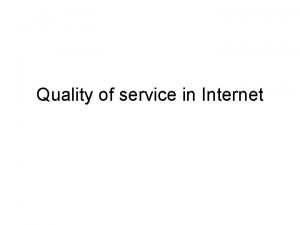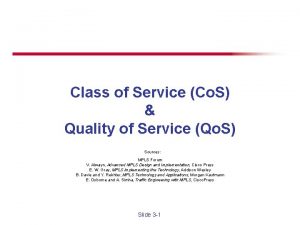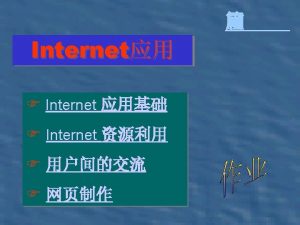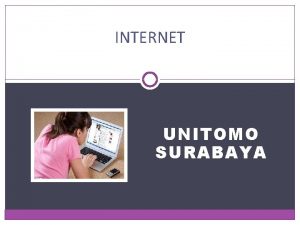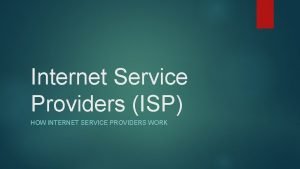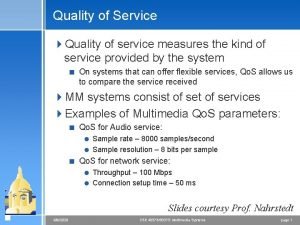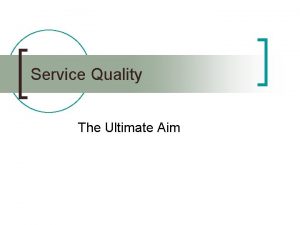Quality of Service in the Internet Dr Vasil








































![Admission Control Flow Requirements: Requested Bandwidth Range (RBR) [Min Rate, Max Rate] = Aggregate Admission Control Flow Requirements: Requested Bandwidth Range (RBR) [Min Rate, Max Rate] = Aggregate](https://slidetodoc.com/presentation_image/499699416ceeaaf078ed5bd861a761b6/image-41.jpg)




- Slides: 45

Quality of Service in the Internet Dr. Vasil Y. Hnatyshin 11/3/2020 Rowan University Vasil Y. Hnatyshin 1

Outline Introduction Qo. S via traffic differentiation n n Qo. S Building Blocks Integrated Services Differentiated Services Bandwidth Distribution Scheme Summary and Conclusions 11/3/2020 Rowan University Vasil Y. Hnatyshin 2

Outline Introduction Qo. S via traffic differentiation n n Qo. S Building Blocks Integrated Services Differentiated Services Bandwidth Distribution Scheme Summary and Conclusions 11/3/2020 Rowan University Vasil Y. Hnatyshin 3

What is Qo. S? What is Quality of Service? What parameters influences perceived network Qo. S? Why do we need Qo. S in the Internet? 11/3/2020 Rowan University Vasil Y. Hnatyshin 4

Internet Architecture What architectural model is being used in today’s Internet? What are IP, TCP, and UDP and how do they work? 11/3/2020 Rowan University APPLICATION TCP/UDP IP MAC TCP/IP Internet Architecture Vasil Y. Hnatyshin 5

How does Internet work? Widener Rowan APPLICATION INTERNET TCP/UDP IP APPLICATION IP MAC TCP/UDP MAC IP IP MAC ISP 11/3/2020 ISP Rowan University Vasil Y. Hnatyshin 6

How to achieve Qo. S? Provisioning Traffic differentiation n 11/3/2020 In ISP routers (and the end nodes) In the Internet core routers Combination of the above Rowan University Vasil Y. Hnatyshin 7

Outline Introduction Qo. S via traffic differentiation n n Qo. S Building Blocks Integrated Services Differentiated Services Bandwidth Distribution Scheme Summary and Conclusions 11/3/2020 Rowan University Vasil Y. Hnatyshin 8

Qo. S Building Blocks Incoming Packet Classifier Rate Controller Admission Control Scheduler Outgoing Packet 11/3/2020 Rowan University Vasil Y. Hnatyshin 9

Classifiers Application block Source/Destination IP addresses Source/Destination ports Transport protocol Type of Service Field (Differentiated Services) Version Header Type of Service Length Total Packet Length … TTL Protocol Header Checksum Source Address Destination Address Options (Variable Size) 11/3/2020 Rowan University Vasil Y. Hnatyshin 10

Classifiers Class #1 Classifier Class #2 11/3/2020 Rowan University Vasil Y. Hnatyshin 11

Admission control Ensures that the load on a particular link is manageable by determining if the new flow can be admitted into the network. Admission Link utilization is 60 % Link utilization is 90 % Control 11/3/2020 Rowan University Vasil Y. Hnatyshin 12

Rate Controllers What are rate controllers and how rate control is achieved? n n Shapers Droppers Common rate control mechanisms n n 11/3/2020 Token bucket Timestamp driven Rowan University Vasil Y. Hnatyshin 13

Rate Controllers Processing Queue Rate Controlle r Delay Queue Dropper 11/3/2020 Rowan University Vasil Y. Hnatyshin 14

Schedulers What are schedulers? Scheduling mechanisms: n n FIFO Priority Queuing w Potential problem? w Preemptive vs. non-preemptive n 11/3/2020 Weighted-Fair Queuing Rowan University Vasil Y. Hnatyshin 15

Priority Scheduler Priority Queue #1 Outgoing Link Priority Queue #2 Priority Queue #3 11/3/2020 Rowan University Vasil Y. Hnatyshin 16

Qo. S Blocks Revisited Incoming Packet Classifier Admission Control SLA Rate Controller Scheduler Outgoing Packet 11/3/2020 Rowan University Vasil Y. Hnatyshin 17

Outline Introduction Qo. S via traffic differentiation n n Qo. S Building Blocks Integrated Services Differentiated Services Bandwidth Distribution Scheme Summary and Conclusions 11/3/2020 Rowan University Vasil Y. Hnatyshin 18

Integrated Services Simplified Idea: for each newly admitted flow reserve network resources at each node on the flow’s path from source to destination. Uses per-flow resource reservation protocol called resource reservation protocol (RSVP). 11/3/2020 Rowan University Vasil Y. Hnatyshin 19

Int. Serv Example Internet Widener Core 1 Core 3 ISP 1 ISP 2 ISP 4 Core 2 Rowan FTP connection from Rowan to CNN Video conference call from Rowan to CNN Allocated resources for corresponding connections FTP connection from Widener to CNN Video conference call from Widener to CNN 11/3/2020 Rowan University Vasil Y. Hnatyshin 20

Int. Serv Summary Main Advantage • Support for fine-grained perflow Qo. S 11/3/2020 Rowan University Main Disadvantage • Resource hogging • Not Scalable Vasil Y. Hnatyshin 21

Outline Introduction Qo. S via traffic differentiation n n Qo. S Building Blocks Integrated Services Differentiated Services Bandwidth Distribution Scheme Summary and Conclusions 11/3/2020 Rowan University Vasil Y. Hnatyshin 22

Differentiated Services Goal: Provide scalable Qo. S. Diff. Serv Implementation: n n 11/3/2020 Establishes a few classes/aggregates Classifies arriving traffic into one of predefined classes. Packets are differentiated based on the DSCP marking set in the IP header. Core routers treat arriving traffic based on the packet’s class. Rowan University Vasil Y. Hnatyshin 23

Diff. Serv Example Internet Widener Core 1 Core 3 ISP 1 ISP 2 ISP 4 Core 2 Rowan FTP connection from Rowan to CNN Video conference call from Rowan to CNN DS Class A DS Class B FTP connection from Widener to CNN Video conference call from Widener to CNN 11/3/2020 Rowan University Vasil Y. Hnatyshin 24

Diff. Serv Summary Main Advantage • Scalability 11/3/2020 Rowan University Main Disadvantage • Providing only coarse-grained peraggregated Qo. S Vasil Y. Hnatyshin 25

Outline Introduction Qo. S via traffic differentiation n n Qo. S Building Blocks Integrated Services Differentiated Services Bandwidth Distribution Scheme (BDS) Summary and Conclusions 11/3/2020 Rowan University Vasil Y. Hnatyshin 26

Idea of the BDS Flow request certain amounts of bandwidth upon activation. Bandwidth flow requirements are aggregated and distributed in the network via Resource Distribution and Feedback Protocol (RDF Protocol). Based on the aggregate flow requirements individual edge routers control the rate of the traffic. 11/3/2020 Rowan University Vasil Y. Hnatyshin 27

BDS Example Internet Widener Core 1 Core 3 ISP 1 ISP 2 ISP 4 Core 2 Rowan FTP connection from Rowan to CNN Video conference call from Rowan to CNN Aggregate Flow Requirements FTP connection from Widener to CNN Video conference call from Widener to CNN 11/3/2020 Rowan University Vasil Y. Hnatyshin 28

Outline Introduction Qo. S via traffic differentiation n n Qo. S Building Blocks Integrated Services Differentiated Services Bandwidth Distribution Scheme Summary and Conclusions 11/3/2020 Rowan University Vasil Y. Hnatyshin 29

Summary and Conclusions The BDS approach has potential to become superior to current Int. Serv and Diff. Serv approaches. BDS Advantages: n n Scalability Per-flow Qo. S Fairness Congestion control 11/3/2020 Rowan University BDS Disadvantages: n n Not tested under reallife scenarios Overhead of the RDF protocol Vasil Y. Hnatyshin 30

Ongoing BDS Research Evaluation of the BDS approach under more realistic scenarios. Dealing with the inter-domain traffic. Extending the BDS framework to mobile environment. Influence of the BDS model on TCP traffic. 11/3/2020 Rowan University Vasil Y. Hnatyshin 31

The BDS Publications V. Hnatyshin and A. S. Sethi, “Reducing load distribution overhead with message aggregation, ” Proc of IPCCC’ 03, Phoenix, AZ (April 2003) V. Hnatyshin and A. S. Sethi, “Fair and Scalable Load Distribution in the Internet, ” Proc. 3 rd International Conference on Internet Computing, Las Vegas, NV (June 2002). V. Hnatyshin and A. S. Sethi, “Achieving Fair and Predictable Service Differentiation Through Traffic Degradation Policies, ” Proc. SPIE Qo. S 2001, Conference on Quality of Service over Next-Generation Data Networks, Denver, CO (Aug. 2001). V. Hnatyshin and A. S. Sethi, “Avoiding Congestion Through Dynamic Load Control, ” Proc. ITCom-2001, SPIE's International Symposium on The Convergence of Information Technologies and Communications, Denver, CO (Aug. 2001). 11/3/2020 Rowan University Vasil Y. Hnatyshin 32

The End! Rowan University Y. Hnatyshin Vasil

Network Architecture Network Domain Core 1 The Internet Network Domain Core 2 Edge B Edge A Edge C Core 3 Edge D Network Domain 11/3/2020 Rowan University Vasil Y. Hnatyshin 34

Diff. Serv Scalability Edge Routers: Network Domain Core 1 Edge B Edge A Edge C 11/3/2020 Core 2 Core 3 Edge D Rowan University • Maintain all per-flow information via SLA • Perform traffic classification • Mark arriving packets Core Routers: • Maintain only class information • Treat arriving traffic based on the DSCP marking Vasil Y. Hnatyshin 35

BDS Edge Node Data Structures Flow List Path Table … Source Destination Data … … Egress node SLA Table Source … … Data Destination … Link Table Complete Path … Link Capacity IP Address Data Arrival Rate IP Address Data Aggregate RBR IP Address Data Path List … … 11/3/2020 Rowan University Vasil Y. Hnatyshin 36

BDS Core Node Data Structures Interfaces Table IP Address Data … 11/3/2020 Link Capacity Arrival Rate Aggregate RBR Edge Nodes List … Rowan University Vasil Y. Hnatyshin 37

BDS Objectives Scalability Per-flow Qo. S Fair distribution of bandwidth Congestion Control 11/3/2020 Rowan University Vasil Y. Hnatyshin 38

BDS Scalability Edge Routers: Network Domain Core 1 Edge B Edge A Edge C 11/3/2020 Core 2 Core 3 Edge D Rowan University • Maintain all per-flow information via SLA • Perform traffic classification • Adjust transmission rate of the flows based on the network feedback Core Routers: • Maintain only aggregate flow requirements • Provide network feedback to the edge routers Vasil Y. Hnatyshin 39

BDS Per-flow Qo. S Admission control Resource management Control protocol Note: Fairness and congestion control achieved via same modules 11/3/2020 Rowan University Vasil Y. Hnatyshin 40
![Admission Control Flow Requirements Requested Bandwidth Range RBR Min Rate Max Rate Aggregate Admission Control Flow Requirements: Requested Bandwidth Range (RBR) [Min Rate, Max Rate] = Aggregate](https://slidetodoc.com/presentation_image/499699416ceeaaf078ed5bd861a761b6/image-41.jpg)
Admission Control Flow Requirements: Requested Bandwidth Range (RBR) [Min Rate, Max Rate] = Aggregate RBR Admission control test: -- A new flow -- A path of a flow -- A flow 11/3/2020 Rowan University -- A link -- Capacity of link k -- A set of flows that travel through link k Vasil Y. Hnatyshin 41

Resource Management Definitions of Fairness: n Proportional Fairness n Maximizing Utility Fairness Per-Flow Resource Allocation 11/3/2020 Rowan University Vasil Y. Hnatyshin 42

The RDF Protocol Purpose: n Distribute the Aggregate RBR among the nodes in the network. Path Probing Phase: n Edge routers periodically probe the network to discover the route changes (e. g. aggregate RBR, excess bandwidth). RBR Update Phase: n Edge nodes notify the core routers about the change of the aggregate RBR due to flow activation or termination. Notification Phase: n Core routers notify the edge nodes about congestion. 11/3/2020 Rowan University Vasil Y. Hnatyshin 43

The RDF Protocol Example Flow F 2 requests to enter the network at Edge 2 to travel to Edge 5 F 1 Edge 1 CN 1. Initiates the Path Probing Phase Probe Reply F 2 2. Updates Local Data Structures 3. Performs Admission Control Test 4. Computes Allocated Rate of F 2 5. Initiates the RBR Update Phase 6. Allows F 2 to enter the network 11/3/2020 Rowan University F 2 Probe C 1 C 2 C 3 CN Edge 2 Edge 6 F 1 Edge 3 Edge 4 Core Router C 1 discovers that link C 1 -C 2 is congested 1. C 1 initiates the Notification Phase. 2. Edge 1 and Edge 2 adjust allocated rates of F 1 and F 2 to eliminate congestion. Vasil Y. Hnatyshin 44

The BDS Architecture Per-Flow Qo. S Per-Flow Admission Control Excess BW Management Resource Allocation RBR Distribution and Feedback Protocol The BDS Framework Congestion Control Network Architecture Scalability Flow Requirements Definitions of Fairness Specifications and Definitions The BDS Objectives 11/3/2020 The BDS Architecture Rowan University Vasil Y. Hnatyshin 45
 Maturidlik
Maturidlik Dimitar obshti
Dimitar obshti Phaser board game
Phaser board game Internet quality of service
Internet quality of service Class of service vs quality of service
Class of service vs quality of service Internet or internet
Internet or internet Quality control and quality assurance
Quality control and quality assurance Quality control vs quality assurance pmp
Quality control vs quality assurance pmp What are quality standards in project management
What are quality standards in project management Quality assurance model in nursing
Quality assurance model in nursing Quality improvement vs quality assurance
Quality improvement vs quality assurance Concept of quality assurance
Concept of quality assurance Quality management gurus
Quality management gurus Crosby quality is free
Crosby quality is free Old quality vs new quality
Old quality vs new quality Hình ảnh bộ gõ cơ thể búng tay
Hình ảnh bộ gõ cơ thể búng tay Lp html
Lp html Bổ thể
Bổ thể Tỉ lệ cơ thể trẻ em
Tỉ lệ cơ thể trẻ em Voi kéo gỗ như thế nào
Voi kéo gỗ như thế nào Tư thế worms-breton
Tư thế worms-breton Chúa yêu trần thế
Chúa yêu trần thế Các môn thể thao bắt đầu bằng tiếng chạy
Các môn thể thao bắt đầu bằng tiếng chạy Thế nào là hệ số cao nhất
Thế nào là hệ số cao nhất Các châu lục và đại dương trên thế giới
Các châu lục và đại dương trên thế giới Cong thức tính động năng
Cong thức tính động năng Trời xanh đây là của chúng ta thể thơ
Trời xanh đây là của chúng ta thể thơ Mật thư anh em như thể tay chân
Mật thư anh em như thể tay chân Phép trừ bù
Phép trừ bù độ dài liên kết
độ dài liên kết Các châu lục và đại dương trên thế giới
Các châu lục và đại dương trên thế giới Thể thơ truyền thống
Thể thơ truyền thống Quá trình desamine hóa có thể tạo ra
Quá trình desamine hóa có thể tạo ra Một số thể thơ truyền thống
Một số thể thơ truyền thống Cái miệng nó xinh thế chỉ nói điều hay thôi
Cái miệng nó xinh thế chỉ nói điều hay thôi Vẽ hình chiếu vuông góc của vật thể sau
Vẽ hình chiếu vuông góc của vật thể sau Nguyên nhân của sự mỏi cơ sinh 8
Nguyên nhân của sự mỏi cơ sinh 8 đặc điểm cơ thể của người tối cổ
đặc điểm cơ thể của người tối cổ Giọng cùng tên là
Giọng cùng tên là Vẽ hình chiếu đứng bằng cạnh của vật thể
Vẽ hình chiếu đứng bằng cạnh của vật thể Phối cảnh
Phối cảnh Thẻ vin
Thẻ vin đại từ thay thế
đại từ thay thế điện thế nghỉ
điện thế nghỉ Tư thế ngồi viết
Tư thế ngồi viết Diễn thế sinh thái là
Diễn thế sinh thái là



